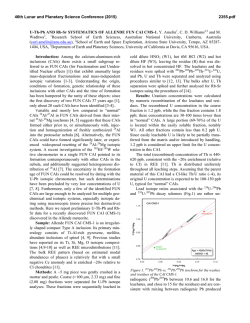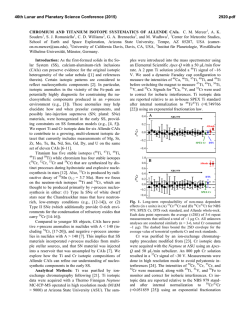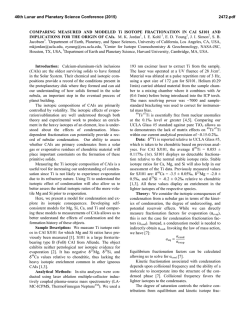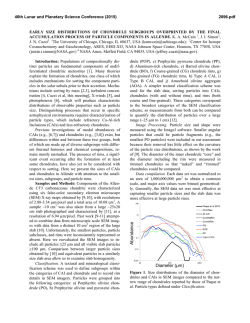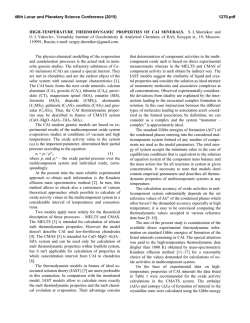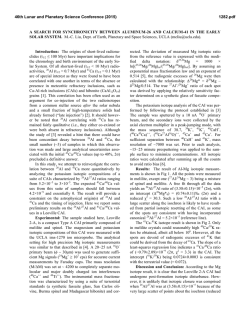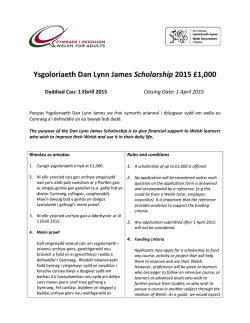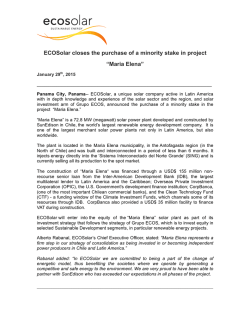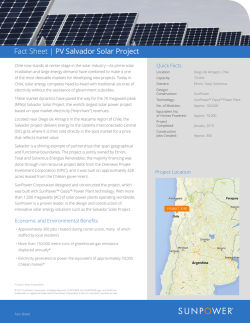
The Search for Supernovae Fingerprints in the Early Solar System
46th Lunar and Planetary Science Conference (2015) 1813.pdf THE SEARCH FOR SUPERNOVAE FINGERPRINTS IN THE EARLY SOLAR SYSTEM: NO SIGNS OF LIVE 126Sn IN ALLENDE CAIs. G.A. Brennecka1,2*, L.E. Borg2, S.J. Romaniello3, A.K. Souders3, M. Wadhwa3, 1 Westfälische Wilhelms-Universität, Münster, Germany, 2Lawrence Livermore National Laboratory, Livermore, CA, 3Arizona State University, Tempe, AZ. (*[email protected]). Introduction: It has been suggested that shockwaves from a nearby supernova triggered the collapse of the molecular cloud that formed our Solar System [1, refs therein]. However, no unequivocal evidence has been found to confirm this hypothesis. If such evidence exists, it would be in the form of extinct radionuclides produced by the aforementioned supernova. The first solids that formed in our Solar System are calcium–aluminum-rich inclusions (CAIs) that indeed provide evidence for the presence of short-lived radionuclides at their time of formation [2]. However, most of these radionuclides can be produced by different processes and in different settings, and do not necessitate injection by a nearby supernova. In contrast, 126Sn (which decays to 126Te with a half-life of ≈ 235,000 years [3]) is produced exclusively by r-process nucleosynthesis in supernovae [4-8]. Because of its very short half-life, the quasi-steady state abundance of 126Sn in the galactic background is negligible. Thus, evidence of extant 126Sn in early Solar System materials would provide unequivocal evidence for supernova injection into the forming Solar System. Conversely, if no evidence for live 126Sn is found, a minimum timespan between the last r-process nucleosynthetic event and the formation of the Solar System (or “free decay interval”) can be calculated. Project Goals: Evidence for live 126Sn would be derived from an excess of its daughter product, 126Te, relative to the Solar System abundance. Because of the relatively short half-life of 126Sn and the predicted timescale of the collapse of the molecular cloud, only the earliest solids in the Solar System could have incorporated live 126Sn. Thus far, finding evidence for the former presence of 126Sn in such solids has been hampered by the following: (1) the range of Sn/Te ratios in CAIs reported in previous studies is quite limited [8], (2) the total amount of Te in previously analyzed CAI samples was very low (<1 ng) [8], and (3) Te is inherently difficult to ionize, so determining the Te isotopic composition with high precision is exceedingly challenging [5]. The goals of this project are to address the above challenges and to utilize the Te isotopic system as a sensitive tracer for investigating potential supernova input into the early Solar System. Methods: Recent work has shown that the instrumental sensitivity for elements that readily form a hydride, such as Te, can be significantly increased by introducing the sample as a hydride gas to the ICPMS [9]. By using a hydride introduction system tuned for Te, elements that do not readily make hydrides under these specific conditions (e.g. Ba) are not ionized. This is important because the Te isotope system has numerous isobaric interferences throughout its mass range, and traditional chemical separation is sometimes inadequate for high-precision measurement. Thus, the hydride generator serves to both significantly increase the ionization efficiency of Te and remove some potential interfering isotopes from samples. By coupling a CETAC HGX-200TM to a Neptune MC-ICPMS at Arizona State University (ASU), we have increased the Te useful ion yield by 8× and increased our overall precision by more than 30× when compared with measurement of Te isotopes using traditional solution MC-ICPMS and a low-flow nebulizer. While this increase in Te sensitivity is essential to making it a viable tracer for nucleosynthetic inputs, other major impediments exist, including inherently low amounts of Te in CAIs, and the limited spread of parent (Sn) and daughter (Te) elements in these samples. A previous study attempting to search for evidence of the former presence of live 126Sn in CAIs used samples that contained <1 ng of Te, with maximum 124 Sn/128Te of 2.5 [8]. Using hydride generation MCICPMS, we have investigated the Te isotopic compositions of eleven large Allende CAIs for which Mg, Ti, Cr, Sr, Zr, Mo, Ba, Nd, Sm, Dy, Gd, and U isotope compositions have been previously reported [10-15]. Tellurium concentrations and 124Sn/128Te ratios of these samples are given in Table 1. Sample Sample ~ppb name weight (g) Te CAI 164 0.705 17 CAI 165 2.838 211 CAI 166 0.173 104 CAI 167 0.368 359 CAI 168 1.343 70 CAI 170 0.199 652 CAI 171 0.199 281 CAI 172 0.441 5674 CAI 173 0.607 140 CAI 174 0.441 1610 CAI 175 0.31 226 Chondrite [16] 2330 *measured on pre-chemistry aliquots ~total ng Te 12 600 18 132 94 130 56 2500 85 710 70 - 124Sn/ 128Te* 2.1 0.8 10 4.1 0.8 2.8 5.6 0.4 2.5 0.7 4.2 0.13 Table 1 – Sample weights, Te concentrations, and 124Sn/128Te ratios of the samples of this study. The samples highlighted in red possess a group-II REE pattern, as shown in [16]. 46th Lunar and Planetary Science Conference (2015) Solutions were purified using methods similar to those published previously [5]. Due to the low natural abundances of Sn and Te in terrestrial rock standards, aliquots of BCR-2, BHVO-2, and BIR-1 were doped with 50 ng each of Sn and Te and processed through the same chemical procedure as the CAIs. Purified cuts of Te were then measured on the Neptune MC-ICPMS at ASU using hydride generation (see above). Results and Discussion: As can be seen in Fig. 1, the Te isotopic compositions of the eleven Allende CAIs analyzed in this study are identical to those of the terrestrial rock standards, within the analytical uncertainties. From these data, we infer an upper limit on the initial 126Sn/124Sn of ≤2.68 × 10-6. Despite the larger range in 124Sn/128Te ratios (from ~0.7 to ~10) and the higher precision of the Te isotope compositions of these samples compared to previous studies, we do not find evidence of extant 126Sn at the time of last equilibration of Te isotopes in these CAIs. Fig. 1 – The measured 124Sn/128Te plotted versus 126Te/128Te in a set of eleven Allende CAIs (red squares) and three terrestrial basalt standards (blue diamonds). Internal normalization was used to correct for instrumental mass bias using the ratio 125Te/128Te=0.22204. Reproducibility of the 126Te/128Te for basalt standards was ±58 ppm (2SD); as such, the precision reported for the CAI samples is either the measured 2SD precision based on several repeats of the sample or the reproducibility (2SD) for the basalt standards, whichever was higher. The maximum possible slope, corresponding to the upper limit on the initial 126Sn/124Sn, calculated based on this data set is shown as the green dashed line. The source of Sn and Te in Allende CAIs is ambiguous since the principle carrier phases for these elements are as yet unknown. Nevertheless, the interpretation of the data presented here depends heavily on whether the Sn and Te in the analyzed samples are predominantly the result of primary CAI formation processes or if they are derived from secondary alteration processes. Both Sn and Te are volatile elements, with condensation temperatures of 704 K and 709 K, respectively [16]. As such, the expected concentrations of these elements in high-temperature condensates should be 1813.pdf considerably lower than their bulk chondritic abundances. Furthermore, since the condensation temperatures of these two elements are similar, their fractionation in the nebular CAI formation environment should be minimal. While the definitive source of Sn and Te in this sample set is still unknown, the following observations may provide hints as to their origin: The concentrations of Sn and Te are lower in CAIs than in bulk chondrites in all but one sample, although the large ranges in these concentrations (and in the Sn/Te ratios) in this sample set may suggest that at least some samples have been affected by secondary alteration. The Sn/Te ratios are lower in coarse-grained samples than in fine-grained samples. This could reflect differences in either their formation or alteration histories. If Sn and Te are principally indigenous to these CAIs, our data could have fundamental implications for the early Solar System. Using the upper limit of the initial 126Sn/124Sn of ≤2.68 × 10-6 inferred from the data reported here (Fig. 1) and assuming a 126Sn/124Sn production ratio of 0.13 [6, 17, 18], a free decay interval of at least 3.7 Ma is inferred. This would call into question the plausibility of a supernova trigger for the collapse of the Solar System. However, if the Sn and Te in the analyzed CAIs are predominantly of secondary origin, the results reported here merely indicate that that there was no live 126Sn at the time of the alteration event. Currently, we believe this scenario to be the more likely one in the context of the observed Sn and Te abundances in these Allende CAIs. In future work, it will be important to analyze additional CAIs from relatively pristine chondrites to place better constraints on the initial Solar System 126 Sn/124Sn ratio. References: [1] Boss & Keiser (2012) ApJ Letters, 756, L9. [2] MacPherson (2014). Treatise on Geochem (2nd Edition) 1. 139-179 Ed.: Davis A. M. (Elsevier Ltd.) [3] Oberli et al. (1999) IJMS, 184, 145. [4] Qian et al. (1998) ApJ, 506, 868. [5] Fehr et al. (2004) IJMS, 232, 83. [6] Fehr et al. (2005) GCA, 69, 5099. [7] Fehr et al. (2006) GCA, 70, 3436. [8] Fehr et al. (2009) MAPS, 44, 971. [9] Forrest et al. (2009) Geostand. Geoanal. Res., 33, 261. [10] Mane et al. (2014) LPS 45, #1685. [11] Mercer et al. (this meeting). [12] Brennecka et al. (2013) PNAS, 110, 17241. [13] Mane et al. (2014) MetSoc 2014, #5403. [14] Brennecka et al. (2014) LPS 45, #2280. [15] Brennecka et al. (2010) Science, 327, 449. [16] Lodders (2003) ApJ, 591, 1220. [17] Meyer & Clayton (2000) Space Sci. Rev., 92, 133. [18] Meyer et al. (2004) LPS 35, #1908.
© Copyright 2025
